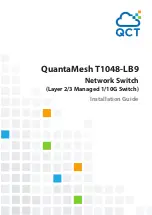
User’s Guide
FUJITSU PSWITCH
December/2018
51
center servers where the larger frame size increases efficiency of the system and
allows processing of more requests.
3.1.2.2.
Flow Control
Flow control enables lower speed switches to communicate with higher speed
switches by requesting that the higher speed switch refrains from sending packets.
Transmissions are temporarily halted to prevent buffer overflows. This feature is
typically used with iSCSI disk arrays.
This feature enables you to configure the switch to use symmetric, asymmetric or
no flow control. Asymmetric flow control allows the switch to respond to received
PAUSE frames, but the port cannot generate PAUSE frames. Symmetric flow control
allows the switch to both respond to, and generates MAC control PAUSE frames.
With no flow control, neither responding nor generating to the PAUSE frame is
done.
Response to
received PAUSE frames
Generation of
PAUSE frames
Symmetric
Flow Control
Enabled
Enabled
Asymmetric
Flow Control
Enabled
Disabled
No Flow Control
Disabled
Disabled
Table 3-1: Flow Control
802.3x Flow control, the MAC control PAUSE operation allows traffic from one
device to be throttled for a specified period of time and is defined for devices that
are directly connected. A device that wishes to inhibit transmission of data frames
from another device on the LAN transmits a PAUSE frame as defined in the IEEE
specification.
When Symmetric flow control is enabled, the ports asserts back pressure to the
MAC, the MAC will respond by generating PAUSE frames, and the partner device
will respond by stopping packet transmission to avoid packet loss. The ports are
also capable of throttling the transmit rate in response to the PAUSE frames
received from peer. When transmission of symmetric flow control frames is enabled,
the entire switch is placed in ingress drop mode. When in ingress drop mode, the
switch will behave like any other ingress buffered switch and exhibit head of line
blocking during times of congestion.
















































